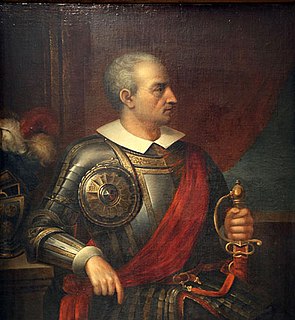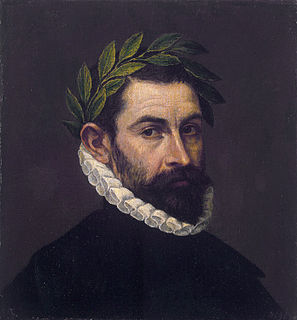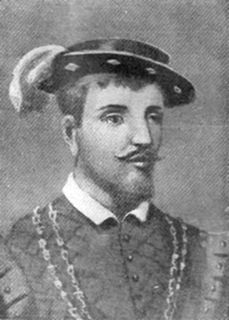
Pedro del Castillo (Villalba de Rioja, 1521 - Panama City, 28 March 1569) was a Spanish conquistador.

Pedro del Castillo (Villalba de Rioja, 1521 - Panama City, 28 March 1569) was a Spanish conquistador.
After acting as corregidor in some recently founded American towns, he was in Chile at the orders of Francisco de Villagra, with whom he took part in the Arauco War. [1]
In November 1560 he was appointed by the Governor of Chile, García Hurtado de Mendoza, as capitán general y teniente gobernador para poblar, fundar, repartir tierras y encomendar indios en la provincia de Cuyo (commander-in-chief and plenipotentiary for the province of Cuyo), in what is now western Argentina. Castillo organized and expedition that crossed the Andes, passing through the Aconcagua and Uspallata valleys, reaching the Huentata valley on 22 February.
On 2 March 1561, Pedro del Castillo founded the city of Mendoza. Some time later, he was sent to Lima, Peru, and afterwards he established himself in Panama. He died in Panama City in 1569.

Diego de Almagro, also known as El Adelantado and El Viejo, was a Spanish conquistador known for his exploits in western South America. He participated with Francisco Pizarro in the Spanish conquest of Peru. While subduing the Inca Empire he laid the foundation for Quito and Trujillo as Spanish cities in present-day Ecuador and Peru respectively. From Peru Almagro led the first Spanish military expedition to central Chile. Back in Peru, a longstanding conflict with Pizarro over the control of the former Inca capital of Cuzco erupted into a civil war between the two bands of conquistadores. In the battle of Las Salinas in 1538 Almagro was defeated by the Pizarro brothers and months later he was executed.

Mendoza, officially Province of Mendoza, is a province of Argentina, in the western central part of the country in the Cuyo region. It borders San Juan to the north, La Pampa and Neuquén to the south, San Luis to the east, and the republic of Chile to the west; the international limit is marked by the Andes mountain range. Its capital city is the homonymous city of Mendoza.

San Juan Province is a province of Argentina, located in the western part of the country. Neighbouring provinces are, moving clockwise from the north, La Rioja, San Luis and Mendoza. It borders with Chile to the west.

Mendoza, officially the City of Mendoza is the capital of the province of Mendoza in Argentina. It is located in the northern-central part of the province, in a region of foothills and high plains, on the eastern side of the Andes. As of the 2010 census [INDEC], Mendoza had a population of 115,021 with a metropolitan population of 1,055,679, making Greater Mendoza the fourth largest census metropolitan area in the country.

Alonso de Ercilla y Zúñiga was a Spanish nobleman, soldier and epic poet, born in Madrid. While in Chile (1556–63) he fought against the Araucanians (Mapuche), and there he began the epic poem La Araucana, considered one of the greatest Spanish historical poems. This heroic work in 37 cantos is divided into three parts, published in 1569, 1578, and 1589. It tells of the courageous insurrection of the Araucanians and also relates the history of Chile and of contemporary Spain.

The Arauco War was a long-running conflict between colonial Spaniards and the Mapuche people, mostly fought in the Araucanía. The conflict began at first as a reaction to the Spanish conquerors attempting to establish cities and force Mapuches into servitude. It subsequently evolved over time into phases comprising drawn-out sieges, slave-hunting expeditions, pillaging raids, punitive expeditions, and renewed Spanish attempts to secure lost territories. Abduction of women and war rape was common on both sides.

The Captaincy General of Chile or Governorate of Chile, was a territory of the Spanish Empire from 1541 to 1818 that was, for most of its existence, part of the Viceroyalty of Peru. It comprised most of modern-day Chile and southern parts of Argentina. Its capital was Santiago de Chile. In 1818 it declared itself independent, becoming the Republic of Chile. It had a number of Spanish governors over its long history and several kings.

García Hurtado de Mendoza y Manrique, 5th Marquis of Cañete was a Spanish Governor of Chile, and later Viceroy of Peru. He is often known simply as "Marquis of Cañete". Belonging to an influential family of Spanish noblemen Hurtado de Mendoza successfully fought in the Arauco War during his stay as Governor of Chile. The city of Mendoza is named after him. In his later position as Viceroy of Peru he sponsored Álvaro de Mendaña's transpacific expedition of 1595, who named the Marquesas Islands after him.

Melchor Bravo de Saravia y Sotomayor was a Spanish conquistador, interim viceroy of Peru, and Royal Governor of Chile.

Francisco Casimiro Marcó del Pont y Ángel was a Spanish soldier and the last Governor of Chile. He was one of the main figures of the Chilean independence process, being the final Spaniard to rule as Royal Governor of Chile from 1815 to 1817, when he was deposed and captured by the patriot forces after the Battle of Chacabuco.

Giovanni Battista Pastene (1507–1580) was a Genoese maritime explorer who, while in the service of the Spanish crown, explored the coasts of Panama, Colombia, Ecuador, Peru and Chile as far south as the archipelago of Chiloé.
The Conquest of Chile is a period in Chilean historiography that starts with the arrival of Pedro de Valdivia to Chile in 1541 and ends with the death of Martín García Óñez de Loyola in the Battle of Curalaba in 1598, and the destruction of the Seven Cities in 1598–1604 in the Araucanía region.
Alonso de Reinoso (1518–1567) was a Spanish Conquistador in Honduras, Mexico, Peru and Chile. He was born in Torrijos Toledo, Spain in 1518. He was married to Catalina Flores de Riofrío before he came to the Americas in 1535.

Juan Jufré de Loayza y Montesa (1516–1578) was a Spanish conquistador who participated in the 1541 expedition of Pedro de Valdivia to Chile. He was the first alcalde of Santiago, Chile and held the position of governor of the Argentine province of Cuyo. He founded the city of San Juan de la Frontera and re-founded the city of Mendoza.
The Royal Governor of Panama ruled over the Spanish colonial administrative district known first as the colony of Darién and later as the colony of Castilla de Oro, which in 1529 was renamed Panamá. This district was subordinated to the Viceroyalty of New Granada on August 20, 1739. There were 113 such governors or presidents during the Spanish conquest and the later periods of Spanish-centered colonialism.

Andrés Hurtado de Mendoza y Cabrera, 3rd Marquis of Cañete was a Spanish military officer and, from June 29, 1556 to his death on March 30, 1561, the fifth Viceroy of Peru.

The Huarpes or Warpes are an indigenous people of Argentina, living in the Cuyo region. Some scholars assume that in the Huarpe language, this word means "sandy ground," but according to Arte y Vocabulario de la lengua general del Reino de Chile, written by Andrés Febrés in Lima in 1765, the word Cuyo comes from Araucanian cuyum puulli, meaning "sandy land" or "desert country".

Huarpe (Warpe) was a small language family of central Argentina that consisted of two closely related languages. They are traditionally considered dialects, and include Allentiac and Millcayac (Milykayak). A third, Puntano of San Luis, was not documented before the languages became extinct.

Villalba de Rioja is a municipality in the autonomous community of La Rioja (Spain), on the southern slopes of the mountains Obarenes. It borders the provinces of Alava and Burgos. Haro 5 km far from the LR-401. By the municipality elapses Esperamalo stream tributary of the Ebro river. The municipality covers an area of 8.96 square kilometres (3.46 sq mi) and as of 2011 had a population of 150 people.

José Nazario Benavídez was an Argentine soldier who rose to the rank of Brigadier General and played a leading role in the Argentine Civil Wars. He was Governor of San Juan Province, Argentina, for almost twenty years in the mid-nineteenth century. His lengthy political career during a period of great turbulence was due to the great respect in which he was held by enemies as well as friends. After leaving office he was imprisoned and then murdered by his guards.